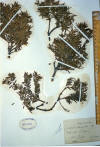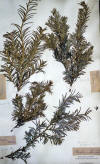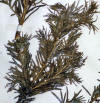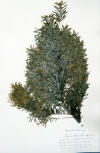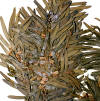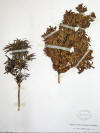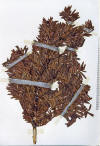18b. Taxus fastigiata
var. nana (Carrière) Spjut,
proposed comb.
nov. (Fig. 127); Taxus baccata
(var.) nana Carrière, Traité gén. Conif. 520. 1855.
Taxus baccata var. foxii Knight ex Gordon, Pinetum,
ed. 2, 391. 1875. Taxus baccata (f.) nana Beissner,
Handb. Nandelholzk. 171. 1891. Origin
unknown. Original material
unknown. Neotype Proposed: Italy: “Iter Sardoum,”
Limbara (Sardinia, Sardegna) 13–16
July 1894, in adnot. T. tournefort (Pal.), V. Martelli (PH
27853!), abaxial surface of leaves lacking papillae entirely across
midrib and across a marginal zone of 10 cells in width, and with 8–9 stomata
rows/band. Italian yew. Distribution: British Isles, Sardinia. Typically low rounded shrubs to 60 cm, or larger in apparent hybrids, with numerous densely congested branchlets arising from a short trunk. Branchlets ± fastigiate, ascending; leaves radial near apex of branchlet, less so below, recurved, elliptical to oblong, rounded obtuse to apex, ~2 cm long and 1.5 cm wide; papillose only on stomata bands, marginal zone 10 cells wide; stomata 8–9 rows/band; male cones erect, to 4 mm diam. This variety is identified by its low erect shrubby habit and by the oblong dark green recurved leaves. This variety (nana) may have been common on Sardinia at elevations to 5660 ft (Elwes & Henry 1906). Presently, clumps of yew are known from the mountainous areas of Punta Sebera and Monte Santo of Pula, occurring with holly (Ilex aquifolium L.) in a southern coast Flora [Gianluigi Bacchetta, www.isolasarda.com/pula-veg_e.htm]. The proposed neotype appears to be a dwarf variety of the Irish yew, which corresponds to a description of var. nana in Carrière (1855, without reference to specimens). The leaf arrangement is similar to that of T. baccata var. glauca, while also appearing similar in shape and color to the Dovaston yew. A leaf anatomical feature that compares favorably with T. fastigiata is the lack papillae entirely across the marginal zone and midrib; however, specimens from the British Isles have a papillose midrib. It is interesting to note that in another specimen collected by Bean & Hill from Tweeddale, Scotland, the collectors considered it was a “distinct variety” for its “plumose growth,” as they noted on their herbarium label. Except for the low habit, the leaf arrangement, color and anatomy might indicate a hybrid between male T. recurvata and female T. fastigiata. The specimen from Tweeddale does not appear to be the same as that shown for ‘Niedpathensis’ in Krüssmann (1985). Other additional specimens cited may also prove to be hybrids. The specimen collected by Ball from England may be a hybrid between T. baccata var. dovastoniana and T. fastigiata; however, there is a strong similarity to Taxus caespitosa of Japan. The affinity to var. dovastoniana is evident in the medial position of epidermal papillae on leaves, and in papillae covering most of the abaxial surface of the leaf (except 4 rows of cells near margins), while affinity to T. fastigiata is evident by the densely congested branchlets with recurved, broad (oblong) leaves tapering to an obtuse apex. The two similar taxa (T. caespitosa and T. baccata var. dovastoniana) might be treated under a single widespread disjunct species that could be defined by the overlapping leaf arrangement, oblong leaf shape, and by the thick shiny cuticle on the adaxial leaf surface. As noted under the typical variety, occasional specimens from E Asia could be placed under the T. baccata Alliance, while occasional specimens of var. jacksonii and var. glauca from N Europe might be placed under taxa of the T. cuspidata Alliance. Based on gross morphological features of color and phyllotaxy, these specimens are referred to the geographical alliances of taxa with the assumption that the deviations in leaf anatomical features are the result of natural hybridization and introgression. On the other hand, leaves of many cultivars of T. fastigiata are less papillose on the abaxial surface; thus, Taxus caespitosa could also be included under T. fastigiata. Molecular data may clarify the relationships of these taxa, although living plants from which these specimens were taken may no longer exist. Representative Specimens—England: Surrey, Jumper Hill, Ball (US). Scotland: Neopath Castle, Tweeddale near Peebles, 22 May 1915, Bean & Hill (K).
|
